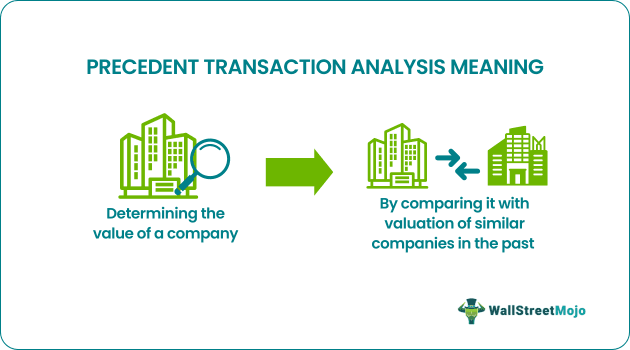Table Of Contents
What Is Precedent Transaction Analysis?
Precedent Transaction Analysis is a valuation technique to determine the value of a company or a business by comparing it to the prices paid for companies in previous similar transactions in the industry. It involves identifying and analyzing completed merger and acquisition (M&A) transactions of comparable companies in the same industry or sector.

When used with other valuation techniques, such as Discounted Cash Flow Analysis and Comparable Company Analysis, it provides a more comprehensive picture of the target company's value. This method provides a concrete reference point for determining a company's fair value by looking at actual transaction prices in the market.
Key Takeaways
- Precedent Transaction Analysis (PTA) is a method used to estimate the value of a company by looking at how similar companies were valued in previous mergers and acquisitions (M&A) deals.
- It is a useful tool for investors, buyers, and sellers who want to understand the value of a company in the current market.
- It also provides insight into market trends and sentiments.
- The advantage of using Precedent Transaction Analysis is that it provides a concrete reference point for determining a company's fair value. It is done by looking at actual transaction prices in the market.
Precedent Transaction Analysis Explained
Precedent transaction analysis is a valuation methodology that determines the value of a company using the value of other companies in previous transactions. It relies on publicly available information, including financial statements, press releases, and other publicly available documents. These are used to identify completed M&A transactions of companies similar to the target company in terms of industry, size, and growth prospects.
The analysis evaluates the transaction value, premium paid, and the financial metrics and ratios of the acquired company to calculate relevant multiples, such as Price-to-Earnings (P/E), Price-to-Revenue (P/R), Price-to-Earnings Before Interest, Tax, Depreciation and Amortization (P/EBITDA), and Price-to-Book Value (P/BV). It focuses on evaluating the financial metrics of the acquired companies and applying those metrics to the target company's financial data to estimate its fair market value.
How To Do?
The following are the steps to perform a Precedent Transaction Analysis:
Step #1
The first step in Precedent Transaction Analysis is to identify completed M&A transactions of companies that are similar to the target company in terms of size, industry, and growth prospects. The transactions should be recent and involve companies that are publicly traded or comparable to publicly traded companies.
Step #2
The next step is to gather data on the transaction. This includes the transaction value, premium paid, and the financial metrics and ratios of the acquired company. These metrics could include revenue, earnings, EBITDA, and other relevant multiples.
One can use the financial metrics of the acquired companies to calculate multiples that are relevant to the target company. Common multiples include P/E, P/R, P/EBITDA, and P/BV.
The multiples are adjusted for differences between the target and acquired companies, such as growth prospects, profitability, and market position. One can make adjustments using industry benchmarks, analyst estimates, and other relevant data.
The adjusted multiples are applied to the target company's financial data to estimate its fair market value. The estimated value is based on the assumption that the target company would be valued similarly to the acquired companies.
Step #3
The final step is to evaluate the results of the analysis and determine whether the estimated fair market value is reasonable based on other valuation methodologies, market conditions, and other relevant factors.
Examples
Let us look at a few examples to understand the concept better:
Example #1
Suppose a private equity firm is considering acquiring a software company and wants to determine its fair market value. They perform a Precedent Transaction Analysis and identify three comparable M&A transactions in the software industry that took place last year. The relevant transaction data is as follows:
Transaction 1:
Acquired Company: XYZ Software
Transaction Value: $500 million
Premium Paid: 25%
Financial Metrics: Revenue of $100 million, EBITDA of $20 million
Transaction 2:
Acquired Company: ABC Software
Transaction Value: $400 million
Premium Paid: 20%
Financial Metrics: Revenue of $80 million, EBITDA of $16 million
The private equity firm calculates the following multiples based on the acquired companies' financial metrics:
P/E: Price-to-Earnings Ratio
P/R: Price-to-Revenue Ratio
P/EBITDA: Price-to-EBITDA Ratio
Multiples:
Transaction 1:
P/E: 25x
P/R: 5x
P/EBITDA: 25x
Transaction 2:
P/E: 25x
P/R: 5x
P/EBITDA: 25x
The private equity firm then adjusts the multiples for differences between the target and acquired companies, such as growth prospects, profitability, and market position. They apply the adjusted multiples to the target company's financial data and estimate its fair market value based on the assumption that it would be valued similarly to the acquired companies.
After evaluating the results of the analysis, the private equity firm determines the estimated fair market value of the software company.
Example #2
One real-life example of Precedent Transaction Analysis is the acquisition of LinkedIn by Microsoft in 2016. In this case, Microsoft acquired LinkedIn, a professional networking site, for $26.2 billion in cash. To determine the fair market value of LinkedIn, Microsoft used Precedent Transaction Analysis to analyze the prices paid for similar companies in the past.
Microsoft identified comparable M&A transactions in the tech industry, such as Facebook's acquisition of WhatsApp and Salesforce's acquisition of ExactTarget. The company analyzed the transaction values, premiums paid, and financial metrics of these companies to calculate relevant multiples, such as P/E, P/R, and P/EBITDA. Microsoft then adjusted the multiples for differences between LinkedIn and the acquired companies, such as growth prospects, profitability, and market position.
After completing the analysis, Microsoft determined that the fair market value of LinkedIn was around $25 billion, close to the final acquisition price of $26.2 billion. The Precedent Transaction Analysis helped Microsoft to determine a reasonable price for the acquisition and provided insight into the valuation of LinkedIn relative to its peers.
Pros And Cons
The pros and cons of precedent transaction analysis are as follows:
Pros of precedent transaction analysis:
- It can provide insight into market trends and investor sentiment, which can help inform investment decisions and strategic planning.
- One can perform the valuation relatively easily using publicly available information, making it a useful tool for quick valuations.
- By analyzing prices paid in previous M&A transactions, Precedent Transaction Analysis provides a market-based valuation. This valuation reflects the true value of a company in the eyes of potential buyers.
Cons of precedent transaction analysis
- It may be difficult to find comparable transactions, especially for companies in niche industries or with unique business models.
- It may not always reflect a company's intrinsic value or future growth potential, as the multiples used in the analysis are based on past performance and market sentiment rather than fundamentals.
- It does not reflect current market conditions or investor sentiment, which can be especially problematic during periods of rapid market changes or disruption.

